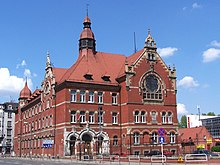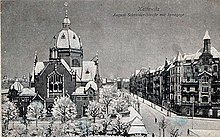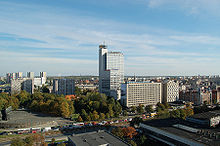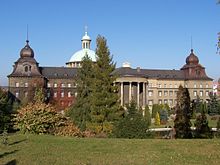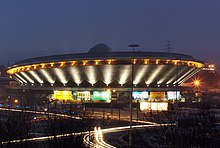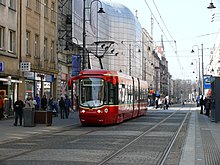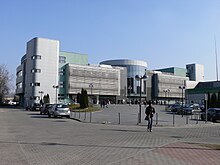Katowice
| Katowice | ||
|---|---|---|

|
|
|
| Basic data | ||
| State : | Poland | |
| Voivodeship : | Silesia | |
| Powiat : | District-free city | |
| Area : | 164.60 km² | |
| Geographic location : | 50 ° 16 ' N , 19 ° 1' E | |
| Height : | 266 m npm | |
| Residents : | 298,111 (December 31, 2016 ) | |
| Postal code : | 40-001 to 40-999 | |
| Telephone code : | (+48) 32 | |
| License plate : | SK | |
| Economy and Transport | ||
| Street : | Dresden - Krakow ( A4 ) | |
| Warsaw - Bielsko-Biała | ||
| Rail route : | Warsaw – Katowice | |
| Katowice – Gliwice | ||
| Next international airport : | Katowice | |
| Gmina | ||
| Gminatype: | Borough | |
| Surface: | 164.60 km² | |
| Residents: | 293,636 (Jun. 30, 2019) |
|
| Population density : | 1784 inhabitants / km² | |
| Community number ( GUS ): | 2469011 | |
| Administration (as of 2015) | ||
| City President : | Marcin Krupa | |
| Address: | ul.Młyńska 4 40-098 Katowice |
|
| Website : | www.katowice.eu | |
[ katɔ'vʲitsɛ ],German Kattowitz (Silesian Katowicy), is the capital of thePolish Silesian Voivodeship. It has around 300,000 inhabitants.
The nearly 80 km northwest of Krakow in the Upper Silesian industrial region lying city is the center of the metropolitan region of Silesia , will be included among the depending on the definition between 2.5 and 5 million inhabitants. There are abundant coal and ore deposits in the area . The city is an important and flourishing business location, with the economic importance of mines and heavy industry declining in favor of the service industry , electrical industry and information technology .
From 1742 Kattowitz belonged to Prussia and, in the wake of the industrial revolution in the 19th century, developed from an insignificant Silesian village into an industrial city that was part of the German Empire from 1871 and after the Treaty of Versailles with the partition of Upper Silesia fell to Poland in 1921. During the Second Polish Republic from 1922 to 1939, Katowice was the capital of the Silesian Autonomous Voivodeship . After the German occupation in 1939 it was 1,941 capital of Gaus Upper Silesia , below in the People's Republic of Poland again capital of the province. In 1924, the population exceeded the 100,000 mark, making it a major city . From 1953 to 1956 the city was named Stalinogród .
Katowice is a university town , a Catholic archbishop's seat as well as an Evangelical Augsburg bishopric (-> Evangelical Augsburg Church in Poland ); The 24th UN Climate Change Conference took place here from December 3 to 14, 2018 ( United Nations Framework Convention on Climate Change or 24th Conference of the Parties , COP 24 for short ).
geography
Geographical location

The city is located in the far east of the Upper Silesia region on a plateau extending from Bytom to Katowice , which has rich coal deposits and is part of the Silesian Highlands . This is also the transition zone between the Beskids and the Polish low mountain ranges. The altitude in Katowice is between 266 and 352 m above sea level , the average in the city is 272 m above sea level. NHN . The main rivers that run through the city are the Rawa , which flows through the city in an east-west direction along the old railway line, and the Klodnitz , which rises south of the city center near the district of Brynów ( Brynow ) and then to the west the Leaving urban area in the direction of Ruda Śląska ( Ruda OS ).
Expansion of the urban area
The urban area of Katowice has an area of 164.6 km², of which about 40% are forests, another 20% are green areas, making the city one of the greenest in the region. Due to the size of the urban area, there are also differences in land use. The largest built-up areas extend in arches from the southwest to the north to the city center and further to the northeast. In the east, but especially in the south-east, there are extensive forest areas and only a few settlements.
City structure
Since September 29, 1997, Katowice officially consists of five city districts (zespoły dzielnic) , which in turn are divided into 22 city districts (dzielnice) .
|
I. Inner city (district)
II. Northern urban area
III. Western urban area
|
IV. Eastern urban area
V. Southern urban area |
Since in this official division several places are sometimes amalgamated into districts and there are other settlements and colonies in addition to these districts, all current and historical districts of Katowice are summarized in a separate article.
Neighboring communities
The independent city is relatively centrally located in the Upper Silesian industrial area and, as the center of this agglomeration, has many neighboring cities and districts that border the city. In the north this is Siemianowice Śląskie and then clockwise, i.e. eastwards, Sosnowiec , Mysłowice , the powiat Bieruńsko-Lędziński with the town of Lędziny , Tychy , the powiat Mikołowski with the town of Mikołów , Ruda Śląska and Chorzów .
climate
Katowice has a predominantly maritime climate, which, however, turns into a continental climate. The annual average temperature is 7.9 ° C , the annual average rainfall 723 mm. From the east, Katowice is protected from winds because of the nearby Kraków-Czestochowa Jura , so that weak westerly winds of no more than 2 m / s predominate.
history
The name of the city is first recorded as Katowicze in 1598 . Before that, however, there are testimonies to today's districts. Dąb is mentioned as early as 1299, Bogucice from 1397.
In the Prussian state
In 1526, the Habsburgs inherited both the Hungarian and the Bohemian royal crowns, thereby gaining control of Silesia. As a result of the Wroclaw Peace Treaty of June 11, 1742, which ended the First Silesian War , Prussia received Upper and Lower Silesia and the County of Glatz , thus also the Upper Silesian village of Katowice.
The rapid rise of the village of Katowice began in 1846 in connection with the construction of the Upper Silesian railway to Myslowitz . The entrepreneur Franz Winckler , the local estate manager Friedrich Wilhelm Grundmann (since 1839), the city planner Nottenbohn and the doctor and first city council chairman of the city of Katowice, Richard , played the outstanding role in bringing together the villages along the Rawa River and developing them into a flourishing city Holtze . In 1865 the rapidly growing Katowice was granted city rights. A quarter of a century earlier, Katowice had been an unsightly village with wooden houses.
Until the fourth mayor, August Schneider , lawyer and notary in Myslowitz, took up his post on August 4, 1890, the trainee a. D. Kosch, who also came from Myslowitz and became second mayor in 1893. August Schneider held office until 1905 and had a lucky hand in his measures for the good of the city. First of all, the tariff war that broke out between Germany and Russia in 1893 caused great damage to industry and trade. The wealthy citizens fled Katowice because of the tax self-assessment, including six millionaires; but just a year later the trade agreement came about and improved the situation. Schneider owes the construction of a slaughterhouse, which is particularly important in the border traffic with Russia, the acquisition of a gas plant for better lighting of the streets and the final overcoming of the economic crisis.
Schneider has made particular merits in the field of expanding the urban school system. The city's magistrate granted the mayor, who has meanwhile been appointed a secret councilor, a double honor: the previous Uferstrasse was renamed August-Schneider-Strasse and Schneider was also granted honorary citizenship.
The Goldstein Palace was built in 1872.
In 1873 Kattowitz received the district office of the newly formed Kattowitz district, formed its own urban district from 1899 and became the seat of large industrial groups (e.g. Kattowitz Aktien-Gesellschaft since 1889) and large banks. Heavy industry based in the city developed favorably. The founding of the Katowice Railway Directorate on April 1, 1895 also brought about a considerable upswing .
At the beginning of the 20th century, Katowice had a Protestant church, two Catholic churches, an Old Catholic church, a synagogue , a grammar school, a high school, a construction school, a preparatory institute , a psychiatric sanatorium and nursing home, two mountain districts , and a district office for the district Katowice , a branch of the Reichsbank , phosphor bronze industry, a wood impregnation plant, roofing felt, ceresin and pottery factories, brickworks, breweries and mills and was the seat of a local court .
The First World War (1914–1918) brought new orders for the steel works . The city was not damaged.
Interwar period

After the First World War, according to the first draft of the Versailles Treaty, Germany was to cede Upper Silesia to Poland without a referendum. After Great Britain had put in its veto, the Ebert government managed to make the division of territory dependent on a referendum. After the final version of the Versailles Peace Treaty , a referendum was planned to decide on the citizenship of Upper Silesia and thus also of Katowice.
The hopes and expectations before the referendum led to tensions between pro-German and pro-Polish population groups, which culminated in the three Silesian uprisings from 1919 to 1921 .
On March 20, 1921, the referendum in Upper Silesia was carried out under the supervision of an inter-allied commission and the presence of the troops of the victorious powers and resulted in a majority of 59.42% for Germany. In the constituency of Katowice, 51.9% of the voters voted for Germany. While a majority of 55.6% of the votes cast was cast in favor of Poland in the associated district of Katowice, 85.4% of the voters in the city were in favor of staying with Germany. This also corresponded to the population structure. The German population in the district of Katowice represented a minority of around 30%, in the urban district of Katowice, on the other hand, an 87 percent majority, of which around 30% were Jewish families who professed their Germans and who played a key role in the city's industrial boom. In the city and district of Katowice taken together, 47.0% voted for Poland.
The victorious powers were also at odds over the dividing borders in Upper Silesia; While Great Britain and Italy tended to defend German interests and wanted to award ¾ of the territory to Germany, France took the opposite position. These conflicts of interest did not remain hidden from the population and led to the outbreak of the third uprising on May 3, 1921 . As a result, the international commission awarded around two thirds of Upper Silesia to Germany and one third, including Katowice, to Poland. With the affiliation to Poland in 1922, the Polish name became the official one instead of the German one. In the months and years that followed, many Germans emigrated from the city and a great many Polish Silesians from the German part of Silesia moved to the city, with the overall population increasing sharply. On July 15, 1924, the neighboring municipalities of Bogucice, Brynów, Dąb, Ligota, Załęska Hałda, Załęże and Zawodzie were incorporated, whereupon the population doubled from around 50,000 in 1921 to 112,822. Nevertheless, a German minority remained in the city, including around 8,000 Germans of Jewish descent.
Katowice became the capital of the Autonomous Voivodeship of Silesia (Autonomiczne Województwo Śląskie) , seat of the Silesian Parliament and the Upper Silesian Mixed Commission (Górnośląska Komisja Mieszana) , but also the location of numerous banks and the center of the Upper Silesian Industrial Region (Górnośowląski) . Thus it came to political, cultural and economic importance and many modern, representative buildings were built, e.g. B. the Silesian Parliament building, the Silesian Museum , the Christ the King's Cathedral , the "skyscraper" Drapacz Chmur and many more in southern districts of the city.
Second World War
During the attack on Poland at the beginning of World War II , the city was occupied by the 239th Infantry Division of the German Wehrmacht on September 4, 1939 , after the Polish army withdrew from Katowice without a fight. There were, however, isolated fights in the city, between civilians - mostly Polish boy scouts - and the German armed forces in the area around the Tadeusz Kościuszko Park, although the exact extent of the fighting is not known. Shortly after the Wehrmacht marched in, around 80 civilian city defenders (mostly insurgents from 1919 to 1921 and boy scouts) were executed. On the other hand, members of the local German population welcomed the invading Wehrmacht soldiers as liberators. On September 8, 1939, Germans set fire to the Great Synagogue on Adam-Mickiewicz -Strasse (formerly August-Schneider-Strasse ) and destroyed the Silesian Museum.
The city (including East Upper Silesia ) was - like almost all areas separated from the German Reich after 1918 - directly annexed to the German Reich . In the months and years that followed, the Polish and Jewish population was persecuted by the German Reich . In the period from September 1939 to April 1941, 8,300 Katowice Jews were deported and mostly murdered in concentration camps.
After joining the Reich, an engineering school was built in Katowice .
post war period
On January 27, 1945, the city was occupied by the Red Army after the German Wehrmacht had withdrawn from the city and the surrounding area without a fight, and numerous crimes against the population occurred. The part of the population that was classified as German was expelled due to the Bierut decrees . Those who were classified as autochthonous , however, received the right to stay. Part of the German population managed to be classified as autochthonous , and so a German minority remained in Katowice and was not expelled. In the 2002 Polish census in the Katowice metropolitan area, it comprised around 20,000 people, which was around 0.5 percent of the region's 3.5 million inhabitants.
After 1945 the city regained its previous position as an industrial and administrative center in the Silesian Voivodeship . The city's importance as a science and cultural center also increased, especially when Katowice became a university town. The population has grown considerably and so has the built-up area. Linked to the upswing was the planned conversion of the city into a model communist city. This was emphasized with the renaming of the city to Stalinogród (Stalinstadt), which was valid from 1953 to 1956 . In the 1970s and 1980s in particular, the cityscape was to be adapted to the ideals of the communists, as is still evident today in prefabricated buildings in the suburbs. But the city center was also affected, for example at the north end of the city center on the Rondo Generała Jerzego Ziętka , which was built in 1965, prefabricated buildings and high-rise buildings, above all the 16-storey apartment block Superjednostka , built between 1967 and 1972, which is still one of the largest residential buildings in Poland today and should accommodate 2800 people in 762 apartments. In the 1970s, a large part of the houses on the Ring from the Wilhelminian era had to give way to new buildings, which destroyed the historic urban structure of the square.
In the meantime, Katowice, but also the entire metropolitan area, attracts the investment capital of many foreign companies more than hardly any other region in the former Eastern Bloc. Due to new office and commercial buildings, but also due to the advancing tertiaryisation , the face of the city is changing from one determined by heavy industry and mines to a modern cultural city characterized by information technology, science and research.
Only a few hundred meters west of the city limits, in the urban area of Chorzów , the roof collapsed on January 28, 2006 when the roof of the largest hall of the Katowice Fair collapsed. 65 people died and a further 141 were injured.
In 2008 the city was awarded the European Prize for their outstanding efforts to European integration thoughts.
Incorporations
The population of the Katowice city center today makes up around 40,000, only slightly more than 12% of the total city population. In contrast to other newly founded Upper Silesian industrial cities, such as Königshütte (Chorzów), which were created through the amalgamation of various settlements and workers' colonies, the growth of the city of Katowice and Katowice initially concentrated on the urban expansion of the inner city, which progressed rapidly. After the Second World War and during the communist period, the size of the urban area quadrupled through the incorporation of nearby cities and municipalities, on whose areas many large housing estates emerged, which resulted in a decentralization of the urban area.
- The first incorporation took place in 1914 with the incorporation of the manor districts Brynow and Kattowitz-Schloss.
- On July 1, 1924, the previously independent communities of Załęże , Bogucice , Brynów and Ligota , which bordered directly on the urban area, were incorporated - the urban area and the number of inhabitants doubled.
- With the communities Wełnowiec , parts of Kostuchna , Panewniki , Piotrowice and Ochojec , new areas of 26.4 km² were added in the south in 1951.
- In 1960, the city of Szopienice was attached to the east, and the towns of Giszowiec , Janów and Dąbrówka Mała were located on an area of around 33 km² .
- A further expansion of the urban area of 65 km² in the south brought the incorporation of the town of Kostuchna including the places Podlesie and Zarzecze and the remote town of Murcki in 1975.
Demographics
Population development
| year | population | Remarks |
|---|---|---|
| 1816 | 486 | Village and three outworks ( district of Beuthen , administrative district of Opole ), all privately owned |
| 1825 | 675 | including five Evangelicals and five Jews |
| 1840 | 1326 | including 60 Evangelicals and twelve Jews |
| 1852 | 1990 | |
| 1867 | 5057 | on December 3rd |
| 1871 | 8129 | including 1200 Protestants and 500 Jews (2000 Poles ); According to other data, 8,132 inhabitants (on December 1), of which 1,468 are Protestants, 5,761 Catholics, one other Christian, 902 Jews |
| 1890 | 16,513 | of which 2,866 Protestants, 12,155 Catholics, 1,483 Jews, nine others (5,000 Poles ) |
| 1900 | 31,738 | 6,263 Protestants, 23,183 Catholics; according to other data, 31,378 inhabitants, including 6,263 Protestants and 2,264 Jews |
| 1905 | 35,772 | |
| 1910 | 43.173 | of which 8,942 Protestants, 31,031 Catholics |
Since the middle of the 19th century there has been a dynamic increase in population. Factors were industrialization and general population growth. In the 20th century, especially as part of Poland, the city grew through numerous incorporations. In 1924 the limit of 100,000 inhabitants was exceeded. Since the political turnaround in Poland in 1989 ( end of the Eastern Bloc ) and the peak of the population in the late 1980s at over 370,000, the city's population has decreased by over 60,000 to around 307,000 today (end of 2012).
In the 2002 census, 296,792 of the then 327,222 inhabitants or 90.7% claimed to be Polish, 17,777 people (5.4%) described themselves as Silesians , 674 (0.2%) as Germans and 165 (0, 05%) as Roma .
Age and employment structure
Katowice is a young city in terms of age structure , statistically speaking 19% of its inhabitants are younger than 18 years, 64% are of working age (19–65 years) and 17% of Katowice are older than 65. The structural change was in the City completed comparatively quickly and new jobs created. At the same time, many people left the city, so that one could speak of full employment . The unemployment rate fell to 1.9% (3,831 registered unemployed) and was thus well below the value of the voivodeship (6.9%) and Poland (9.5%) (as of December 31, 2008). In 2004, 15,258 people, or 7.7%, were unemployed in 2006, 10,810 or 5.4%, and in the same period of 2007, 6,826 people, or 3.4% of the employed. In view of the global financial crisis , however, the situation has since deteriorated. The unemployment rate rose from 4.3% at the end of 2011 to 5% in March 2012 and then leveled off at 4.8%. Katowice still has the lowest rate in the voivodeship (average 10.2%).
Religions
Up until the Second World War, the city was shaped by both Christian denominations and the Jewish faith . Today the Catholic episcopal city is almost exclusively inhabited by Catholics who belong to 17 parishes . Katowice is also the seat of the Katowice diocese of the Evangelical-Augsburg Church with a parish in the Szopienice district and in the city center.
Since the areas of Upper Silesia were largely re-Catholicized in the course of the Counter Reformation , the population of the village of Katowice, both Germans and Poles, was Catholic. The town elevation in 1865 did little to change this situation, even if the proportion of other faiths increased. In 1860 Katowice became its own parish and received its first wooden Catholic church on today's Plac Wolności. The building was later demolished due to dilapidation and the property was given to the Old Catholic Parish founded in 1874 . The Marienkirche was built in 1870 and has since served as the new parish church. A second church was built in 1902 with the Peter and Paul Church in the south of the city. This was followed in the inner city area by the garrison church in 1933, the historic Michael’s Church , which was moved to Katowice in 1938, the Christ the King’s Cathedral in 1955 and in 1977 the Church of the Transfiguration of the Lord in place of the Old Catholic Church.
The proportion of Evangelicals in the total population of Katowice had increased sharply, especially since industrialization. In 1857 a Protestant congregation was founded. Even if the Protestants were in the minority, thanks to donations from the Protestant city fathers, they built the city's first church with their Resurrection Church a year later . Until then, services were held in the Marthahütte. The evangelical school was founded in 1860. Compared to other cities in Catholic Upper Silesia, Katowice had a relatively large Protestant community with 8,831 members in 1910, making up 20.4% of the population. After 1922, when Katowice became part of Poland, many turned their backs on the city and after 1945 most of the German Protestants were expelled, so that today only a few belong to this religious community.
Likewise, the city of Katowice traditionally had a large Jewish population. In 1733 this group can be traced for the first time in the village of Katowice, but their number remained low in the following decades. From 1781 to 1787 no Jews were allowed to settle in the city by royal decree. From 1825 Jews settled in Katowice again, their number increasing to twelve by 1844. With industrialization, of which they were co-founders in the city, their numbers increased greatly, and many new businesses and industrial plants were founded by them. On April 4, 1862, the Jewish community was founded and the first synagogue was built on August-Schneider-Strasse (today ul. Mickiewicza ). A mikveh followed in 1867 and the Jewish cemetery was laid out in 1868 . The importance of the Jewish community in Katowice is evident in the international Jewish conference Chovvei Zion , which met here from November 6th to 11th, 1884 under Leo Pinsker , and in the construction of the new synagogue in 1900. According to the 1910 census, 2,975 Jews (6.9% of the total population) lived in the city. This number also exceeded the Upper Silesian average, the Jewish community of Kattowitz even represented 16% of the total number of Jews in the Opole administrative district. In 1932 - after the suburbs were incorporated - around 9,000, which was roughly the same percentage. Due to the increasing anti-Semitism in interwar Poland, many Katowice Jews were forced to leave the city. Then there was the fear of an attack by the National Socialist neighboring country Germany, so that the Jewish community still had 8,785 members in 1939. The occupation of Katowice by Hitler's Germany on September 3, 1939 finally put an end to the existence of the large community: The large synagogue was burned down and then completely destroyed, almost all Jews were deported from the city and most of them were killed in concentration camps . After the war, around 1,500 Jews lived in Katowice again, many of whom emigrated to Israel in the 1960s.
politics
City President
The Katowice mayor called to German time mayor (1866-1920 and 1939-1945). In the inter-war period (1922-1939) and in the post-war period until 1950, they ruled as city presidents (prezydent miasta) , since March 24, 1950, as chairman of the city council. On January 1, 1974, the presidential function was reintroduced and continued after the first democratic self-government elections in Poland on May 27, 1990. Marcin Krupa has been city president since 2014.
In the 2018 election, Krupa, who is himself non-party, was supported by the right-wing conservative PiS and the left-wing SLD . The vote brought the following result:
- Marcin Krupa (Election Committee Marcin Krupa) 55.4% of the vote
- Jarosław Makowski ( Koalicja Obywatelska ) 24.1% of the vote
- Jarosław Gwizdak (Electoral Committee Right to Katowice) 10.6% of the vote
- Ilona Kanclerz ( Silesian Regional Party ) 6.0% of the vote
- Remaining 3.9% of the vote
Krupa was thus re-elected in the first ballot.
City council
The city council consists of 28 members and is directly elected. The 2018 city council election led to the following result:
- Koalicja Obywatelska (KO) 33.5% of the vote, 12 seats
- Election Committee Marcin Krupa 29.9% of the vote, 11 seats
- Prawo i Sprawiedliwość (PiS) 20.0% of the vote, 5 seats
- Silesian Regional Party 5.9% of the vote, no seat
- Electoral committee right to Katowice 4.3% of the vote, no seat
- Sojusz Lewicy Demokratycznej (SLD) / Lewica Razem (LR) 3.5% of the votes, no seat
- Remaining 2.9% of the vote, no seat
coat of arms
| Blazon : “The coat of arms of the city of Katowice is divided and shows as the main motif a black iron hammer on a yellow background that hits an anvil . Theiron hammer's gear is on the left, while the hammer points to the right. The shield base is again divided. Above you can see a brown cross bar with wood grain, below is a blue background. " | |
| Foundation of the coat of arms: The iron hammer stands for the Bogutzker hammer on the Rawa, which was the basis for economic development and a symbol of the early community and therefore appeared in an old community seal as early as 1816. The wooden beam serves on the one hand as the floor for the hammer, on the other hand it emphasizes the need for wood for iron smelting and thus also for the development of the city. The same is true of the blue background, which symbolizes the water that was used to operate the iron hammer and for industrial purposes. In addition, the water of the Rawa was dammed in the hut pond for the Bogutzker hammer. |
After the first use of the coat of arms in 1816, the content of the coat of arms remained largely unchanged; only the graphic design was subject to certain changes. The coat of arms was adopted as the official coat of arms of the city of Katowice after the city elevation in 1865. The coat of arms of that time showed a larger cog wheel and in the base of the shield only the yellow year 1866 on a red background. The year indicated the first municipal assembly on May 14, 1866. In 1937 the coat of arms was confirmed, but the year was replaced by a red wooden beam. The last change was introduced in 2005 when the gear and hammer were enlarged again and the wooden beam was colored brown.
Town twinning
The city of Katowice is a member of various international organizations and associations such as Eurocities or ICLEI and has partnerships with the following cities:
- Miskolc ( Hungary ) since 1973 (renewed in 1993)
- Mobile ( United States , Alabama ) since 1990
- Cologne ( Germany ) since 1991
- Odense ( Denmark ) since 1992
- Groningen ( Netherlands ) since 1992
- Saint-Étienne ( France ) since 1994
- Ostrava ( Czech Republic ) since 1996
- South Dublin County ( Republic of Ireland )
- Shenyang ( People's Republic of China )
- Salzgitter (Germany)
Culture and sights
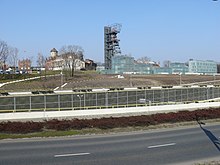

Museums
- The most famous museum in Katowice is the Silesian Museum (Muzeum Śląskie) . The museum was founded by the decision of the Silesian Parliament (Sejm Śląski) on January 23, 1929. Initially, the exhibits were displayed in the building of the Silesian Parliament, but at the same time the construction of the modern, representative new building for the museum, based on the project of the Katowice architect Karol Schayer, began. This building was razed to the ground by the Germans on September 8, 1939 as a symbol of the efforts of Silesia and Poland to achieve autonomy, and the preserved exhibits were taken to the Upper Silesian Museum in Bytom. In 1984 the Silesian Museum was re-established. A representative neo-renaissance building, the former Grand Hotel Wiener , on al. Korfantego 3 elected. Today his collections mainly include ethnological and archaeological exhibits related to the city and the Upper Silesia region. The museum also houses a picture gallery of Polish painting from the 19th and 20th centuries, which already had 250 works of art in its founding year. In addition, the museum is the location of various traveling exhibitions that thematically also concern other regions. In 1986 the first plans began to give the museum a new home. For this purpose, an architectural competition was advertised, which the Warsaw architect Jan Fiszer won. However, his proposal was not carried out, but the site of the disused Ferdinandgrube / KWK Katowice colliery was used to build a completely new museum there. This was opened in summer 2015.
- The Museum of City History ( Muzeum Historii Katowic ) , which was founded in its current form in 1981, is located in a beautiful Art Nouveau town house from 1908 at ul.Szafranka 9 . The most important permanent exhibition deals with the history of the city from 1299 to 1990 with the help of numerous illustrated movable walls, original documents and ethnological pieces of equipment. In addition, the more than 30 portraits of Stanisław Ignacy Witkiewicz and woodcuts by Paweł Steller deserve attention. An entire floor of the building is occupied by two apartments that have been preserved in their old room layout. The equipment of these apartments was supplemented by furniture from other Katowice and Upper Silesian town houses. The premises document life in a typical medium-sized as well as an upper-class apartment in Katowice at the turn of the century. The museum holdings are complemented by historical photographs and postcards of Katowice and porcelain from the Giesche company.
- Founded in 1990 as a branch of the Silesian Museum, the Museum of Polish Set Designers (Centrum Scenografii Polskiej) at Plac Sejmu Śląskiego 2 has gained an international reputation through exhibitions abroad. The museum is the only one in Poland that exclusively exhibits props, of which over 7000 can be visited.
- The Archdiocesan Museum is located in the Archbishop's Palace at ul.Jordana 39 south of Christ the King's Cathedral . The museum, in which works of Upper Silesian church art are exhibited, was opened in 1983. The Gothic , polychrome-plated Madonna figures, which, like the other exhibits, come from churches in the area, are particularly valuable . In addition, traveling exhibitions on the subject of church art are held in the Fra Angelico Gallery, which opened in 1987 . Until the cathedral was completed in 1957, the St. Peter and Paul Church , built in 1898–1902, had served as a bishop's church.
- The Paweł Steller Museum at ul. Andrzeja 13 deals with the life of the Polish painter and renowned wood carver Paweł Steller (1895–1974), who lived in Katowice for many years.
- The Museum of Law and Jurists in Poland (Muzeum Prawa i Prawników Polskich) opened in 1975 at ul.Arzeja 19 is unique in Europe . Over 2000 exhibits illustrate the history of Polish lawyers from the 18th century to the present and during World War II. The collections include exhibits such as a book of the Laws and Privileges of the Kingdom of Poland from 1739 or an application from 1756.
- In Katowicer district Panewnik in Ligota is located at ul. Panewnicka 76 the Mission Museum of the Franciscans . It is headed by the Franciscans of the nearby Franciscan monastery and has the work of the order as its theme.
- The Izba Śląska Museum of Local History is located in the Giszowiec colony on the market square 3-3a (Plac pod Lipami) . It was set up in an old company residence and serves as a cultural center for Upper Silesian traditions. The interior was equipped accordingly, in which works by the painter Ewald Gawlik can also be viewed.
- The Archangel Michael Church , a scrap wood church, was built as part of a planned and unfinished open-air museum.
theatre
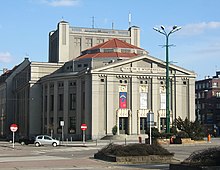
- The Silesian Theater (Teatr Śląski im. Stanisława Wyspiańskiego) not only occupies a central place on the Ring in Katowice and is one of the city's landmarks; it is also the largest and most important Upper Silesian theater. It bears the name of the Polish painter and playwright Stanisław Wyspiański . The building opened on October 2, 1907. The Cologne architect Carl Moritz created a disproportionately large theater with 410 seats for a city with almost 40,000 inhabitants, which would have fit into a big city due to its cultural offer and also due to its architecture as well as its impressive size. After Eastern Upper Silesia was assigned to Poland, the theater also became Polish; However, due to the minority protection agreement concluded on June 28, 1919, a German theater community was set up, which was played by German theaters.
- The Kinoteatr Rialto at ul. Św. Jana 24 was created as early as 1913 as a cinema theater chamber light plays . In 1928 the German name was replaced by Rialto under public pressure . After its reopening on September 11, 2005, it mainly shows films, but the premises have also been adapted (as in its early years) for concerts, theater and cabaret. From 2004 to 2005, the exterior and interior of the Rialto Cinema were renovated, restoring the relief above the main entrance showing a chariot , as well as the original appearance and window layout of the facade, which had been simplified over time. The interior now again impresses with its Art Deco furnishings.
- The GuGalander Club at ul. Jagiellońska 17a is a non-profit theater founded in 1986 as Teatr GuGalander . Discussion forums on music, theater and film are also held here.
- The Silesian Puppet Theater Ateneum (Śląski Teatr Lalki i Aktora Ateneum) has been in existence since 1945 and also organizes the International Puppet Theater Festival in Katowice.
- The Korez Theater is located at Sejmu Śląskiego 2 Square . The small theater was originally founded in 1992 in Chorzów and, due to its size, offers the possibility of involving the audience in the events.
- The Teatr Cogitatur at ul. Gliwicka 9a can look back on more than 20 years of history . The actors of the Cogitatur have international experience and appeared at the Expo 2000 in Hanover , among others . Every year in September, the theater is also the site of the International Theater Festival APAR'T (Międzynarodowy Festiwal Teatralny APAR'T) .
- Estrada Śląska Cultural Institution is located at ul. Kościuszki 88 . It has existed under a changing name and at times as a state-owned company since 1949. It has existed in its current form since the 1990s and organizes various events and festivals related to music and theater, among other things.
- The theater Spiele und Menschen (Teatr Gry i Ludzie) , founded in 1996 and located at al. Niepodległości 2 is located in the former Dąbrówka Mała railway station , where a coal loading ramp used to be. The theater attaches great importance to visual events, which it also stages outside of the theater hall and for children.
music
- The Silesian Philharmonic (Filharmonia Śląska) held its first concert on May 16, 1945. Since then, it has developed into one of the most important music institutions in Poland and is now the only philharmonic in Poland that has three music ensembles with the chamber orchestra , the symphony orchestra and the choir . The International Conducting Competition (Międzynarodowy Konkurs Dyrygentów) , which has been held every four years since 1979, is dedicated to the most famous Polish conductor, Grzegorz Fitelberg . The Philharmonic is housed in a building at 2 Sokolska Street.
- In 1935 the National Symphony Orchestra of Polish Radio (Narodowa Orkiestra Symfoniczna Polskiego Radia) was founded in Warsaw . It was not possible to perform during the Second World War, but the symphony orchestra was re-established in Katowice in 1945. The seat of the renowned orchestra, which has performed numerous times abroad, is in the Upper Silesian Cultural Center at Plac Sejmu Śląskiego 2 .
- On October 1, 2014, a new music center with a new concert hall for the National Symphony Orchestra of Polish Radio was inaugurated. This NOSPR concert hall has 1800 seats and is said to be one of the best concert halls in Europe.
Sports
- After the collapse of the Frisch Auf Kattowitz football club, which was formed in 1904, the three clubs SC Diana Kattowitz , SC Germania Kattowitz and 1. FC Kattowitz (1. FCK) were founded in 1905 , and together they formed the Katowice Ball Game Association . 1. FCK was the most successful sports club in the city even after Katowice was assigned to Poland and became Polish runner-up in 1927. In 1945 all "German" associations were dissolved. However, 1. FCK was re-established in 2007 by the Movement for the Autonomy of Silesia and has since played as 1. FC Katowice in regional Silesian leagues.
- The GKS Katowice is the most important football club in the city. It was founded in 1964 and has already won several Polish Cup and Super Cup winners.
- Rozwój Katowice played one season in the second-rate first division .
- There is also an ice hockey club under the name GKS Katowice , which has won several Polish championships.
- The AWF Mickiewicz Katowice is a successful basketball club and Polish first division club that was founded in 1999.
- The Katowice WTA tournament has been held in Spodek since 2013 .
Regular events
- Many different festivals and other cultural events are held in Katowice every year. One of the most important events in the city and the region is the Rawa Blues Festival , the largest and most traditional blues festival in Poland and, since 1992, of international importance. It took place for the first time in April / May 1981 in the Spodek and is visited by more than 10,000 people every year.
- The annual Metalmania Festival is also held in the Spodek and has been performing metal and hard rock groups since it was founded in 1986 .
- Since 2000, the Mayday techno event has also taken place in Katowice Spodek every year on November 10th .
- The Polish Director's Festival (Ogólnopolski Festiwal Sztuki Reżyserskiej “Interpretacje”) , which is held annually in March and where young directors who have not been active for more than 15 years, have the opportunity to present their works to a wide audience, has nothing to do with music . Until 2003 it was headed by Kazimierz Kutz .
- The Off Festival has been held annually since 2006 , at which international artists present their music, literature and graphic art.
- Every four years the Silesian Philharmonic organizes the International Conducting Competition (Międzynarodowy Konkurs Dyrygentów im. G. Fitelberga) , which is one of the most important competitions of its kind.
- In addition, the International Military Orchestra Festival (Międzynarodowy Festiwal Orkiestr Wojskowych) and the International Graphic Exhibition (Międzynarodowa Wystawa Grafiki Intergrafia) take place in Katowice .
- Every year in Katowice e-sports tournaments take place in the Spodek-Arena, for example competitions of the Intel Extreme Masters Season and the ESL One.
Economy and Infrastructure
Long-distance transport
The transport connections of Katowice are very good compared to Poland thanks to its location in the metropolitan area of the Upper Silesian industrial area .
The city is connected to the important east-west connection, the A4 motorway from Dresden to Krakow , and the north-south connection, the E 75 expressway from Warsaw via Częstochowa to Bielsko-Biała . Around 20 km west of the city in Gliwice -Sośnica there is a large motorway junction between the A4 and the new Polish north-south connection, the A1 motorway . There is a direct expressway connection from Katowice to Skoczów ( E 75 ) near the Czech border and to Olkusz ( E 40 ) to the northeast . Furthermore, the so-called Drogowa Trasa Średnicowa (DTŚ) connects Katowice with all neighboring cities up to Gliwice; To the north of the city center, it forms the Rondo Generała Jerzego Ziętka , a large roundabout, with the inner-city ul. Korfantego . It is planned to further expand this route to the east and north-west. Overall, the city center is enclosed in the north by State Road 79, in the east by the 86, in the south by the A4 and in the west by the 81, which in fact form a ring road .
The Katowice railway station is one of the most important railway junctions in Poland. From here, in addition to regional connections, all major Polish cities can be reached and there are direct connections to major cities in neighboring countries such as Berlin , Hamburg , Vienna , Prague and Bratislava .
There are also direct night train connections with the following destinations: Danzig / Gdynia , Kołobrzeg , Świnoujście , Berlin, Vienna.
Local transport
Katowice is connected to the most important neighboring cities by the tram network in the Upper Silesian industrial area. It is the largest shareholder in the Tramwaje Śląskie transport company . All lines are integrated into the municipal transport association ZTM . It also has a bus network operated by PKS Katowice. The gauge of the tracks is standard gauge .
Katowice is the seat of the regional railway company and a central transfer point for Koleje Śląskie .
Airport
Katowice Airport is located 30 km from the city center with international scheduled flights. Katowice-Muchowiec Airport is 4 km from the city center and is only used for general aviation .
economy
Katowice forms the center of the Katowice Special Economic Zone (Polish Katowicka Specjalna Strefa Ekonomiczna ). Traditionally, the mining and metallurgical industries are particularly well represented along with mechanical engineering. However, in the course of structural change, these heavy industry companies were often downsized or dissolved. For example, the Silesia City Center shopping center was built on the site of the disused Gottwald coal mine . The Galeria Katowicka shopping center was created through the superstructure of Plac Wilhelma Szewczyka and the renovation of the main train station .
The following companies have invested in Katowice: IBM , Capgemini , Unilever , Rockwell Automation , Oracle , PwC , Deloitte , Vattenfall , Kroll Ontrack , ING , ABB , Bombardier , Mentor Graphics and United Pan-Europe Communications. Despite the structural change, the two large mining companies, Kompania Węglowa SA and Katowicki Holding Węglowy , still have their headquarters in the city.
Education and Research
Katowice is still not only the economic and political, but also the cultural center of the Upper Silesian industrial area. The ongoing structural change in Katowice and the decline in the importance of heavy industry can also be observed very well in the example of colleges and universities , of which there are now over 20 in the city. The largest of these is the University of Silesia (Uniwersytet Śląski) with 45,716 students studying at six branches in Sosnowiec , Cieszyn , Jastrzębie-Zdrój , Chorzów , Rybnik and Katowice. Research is carried out in numerous areas (e.g. medicine and physics). The smallest Katowice universities, however, only have a few hundred students. Part of the Silesian Technical University is also located in Katowice . Research is carried out here in the fields of metallurgy, materials science and logistics.
All Katowice universities together offer around 100,000 students a study place. In the past 15 years, that number has more than quadrupled. Statistically speaking, 67% of Katowice's 20 to 24-year-olds have a university entrance qualification or a technical college degree, while comparatively less than 30% of 25 to 29-year-olds have completed a university degree. This tendency becomes even clearer if one considers the percentage of university graduates among the total Katowice population, which is only 16%. In addition, the high standard of education is guaranteed by 55 primary schools (szkoła podstawowa) , 35 middle schools (gimnazjum) , as many grammar schools (liceum) and 45 vocational high schools (technical center) in all age groups.
Also worth mentioning are the 50 libraries in the city area, of which the most modern library in Poland, the Silesian Library (Biblioteka Śląska), deserves special mention. It was founded in 1922/1924 as the library of the Silesian Parliament and took on a public character in the 1930s. Since 1934 the library has been housed in a classically modern building on ul. Francuska , but the premises soon no longer offered enough space, as the library has had the right to deposit copies since 1969 . In 1989, construction began on the new library building at 1 Rady Europy , which was inaugurated on October 24, 1998. Since then, Katowice has had a library building on a European scale. The library's holdings include a million volumes, including the Upper Silesian section Silesiana , as well as old manuscripts and maps.
In 1972 the Institute for Ecology of Industrial Areas (IETU, Polish Instytut Ekologii Terenów Uprzemysłowionych ) was founded - under this name since 1992. Here u. a. researched on circular economy.
Personalities
Well-known personalities born in Katowice include the painter and graphic artist Hans Bellmer , the physicist and Nobel Prize winner Maria Goeppert-Mayer , the SS functionary Wolfgang Otto , the journalist Henryk M. Broder and the EU Commissioner in the Juncker Commission , Elżbieta Bieńkowska .
literature
- Felix Triest : Topographical Handbook of Upper Silesia , Wilh. Gottl. Korn, Breslau 1865, pp. 364-368 .
- Jerzy Moskal, Wojciech Janota: … Bogucice, Załęże et nova villa Katowice. Śląsk, Katowice 1993, ISBN 83-85831-35-5 .
- Lech Szaraniec: Osady i osiedla Katowic. Artur, Katowice 1996, ISBN 83-905115-0-9 .
- Helmut Kostorz (ed.): Kattowitz - his past and present. An anniversary book for the 120th year of foundation. Oberschlesischer Heimatverlag, Dülmen 1985, ISBN 3-87595-075-5 .
Web links
- City website
- private site city and district of Katowice (Polish: Katowice). Retrieved December 17, 2014 .
- Katowice . In: Meyers Konversations-Lexikon . 4th edition. Volume 9, Verlag des Bibliographisches Institut, Leipzig / Vienna 1885–1892, p. 620.
- New inner city planning for Katowice by sztuka-architektury (Polish)
- German-language publications about Katowice / Kattowitz at LitDok East Central Europe / Herder Institute (Marburg)
- Katowice.eu: Report on the state of Katowice (January 2005, Polish, latest publicly available version; PDF file; 11.15 MB)
Individual evidence
- ↑ population. Size and Structure by Territorial Division. As of June 30, 2019. Główny Urząd Statystyczny (GUS) (PDF files; 0.99 MiB), accessed December 24, 2019 .
- ^ Website of the city, Prezydent Miasta Katowice ( Memento of the original from March 8, 2010 in the Internet Archive ) Info: The archive link has been inserted automatically and has not yet been checked. Please check the original and archive link according to the instructions and then remove this notice. , accessed January 27, 2015
- ↑ Reinhold Olesch : The vocabulary of the Polish dialect of Sankt Annaberg . Berlin 1958.
- ↑ a b c Meyer's Large Conversation Lexicon . 6th edition, Volume 10, Leipzig / Vienna 1907, p. 757 .
- ↑ in the visitation report of Father Kazimierski there is talk of a parish that includes Boguczyce, Zalęzie et nova villa Katowicze .
- ↑ Österreichische Landsmannschaft (ed.): Österreichische Landsmannschaft . In: oelm.at , accessed on December 8, 2017.
- ^ Felix Triest : Topographisches Handbuch von Oberschlesien , Wilh. Gottl. Korn, Breslau 1865, pp. 364-368 .
- ^ W. Majowski (Ed.): 100 Years of the City of Katowice 1865–1965.
- ^ Wolfgang Klee: Prussian Railway History . Kohlhammer, Stuttgart 1982. ISBN 3-17-007466-0 , p. 179.
- ^ Michael Rademacher: German administrative history from the unification of the empire in 1871 to the reunification in 1990. City and district of Katowice. (Online material for the dissertation, Osnabrück 2006).
- ↑ according to Jochen Böhler : The attack: Germany's war against Poland , 2009, p. 120 ff., The - wrong - image was maintained by the official side after 1945 that Katowice had been vigorously defended. Böhler cites p. 123 ff. Indications that the boy scouts fighting for the parachute tower are a legend. In the entire industrial area, only nine Wehrmacht soldiers and six Freikorpsmen died on September 4, 1939 (Böhler, p. 130).
- ↑ The Red Army had launched a major offensive ( Vistula-Oder operation ) on January 12 and had made rapid progress.
- ↑ Alexander August Mützell and Leopold Krug : New topographical-statistical-geographical dictionary of the Prussian state . Volume 2: G – Ko , Halle 1821, p. 315, item 1512 .
- ↑ Johann Georg Knie : Alphabetical-statistical-topographical overview of the villages, spots, cities and other places of the royal family. Prussia. Province of Silesia, including the Margraviate of Upper Lusatia, which now belongs entirely to the province, and the County of Glatz; together with the attached evidence of the division of the country into the various branches of civil administration. Melcher, Breslau 1830, p. 322 .
- ^ Johann Georg Knie : Alphabetical-statistical-topographical overview of the villages, spots, cities and other places of the royal family. Preusz. Province of Silesia. 2nd Edition. Graß, Barth and Comp., Breslau 1845, p. 277 .
- ^ A b Gustav Neumann : The German Empire in geographical, statistical and topographical relation . Volume 2, GFO Müller, Berlin 1874, p. 178 .
- ^ A b Royal Statistical Bureau: The municipalities and manor districts of the province of Silesia and their population. Based on the original materials of the general census of December 1, 1871. Berlin 1874, pp. 338–339, number 1 below .
- ↑ a b c d M. Rademacher: German administrative history from the unification of the empire in 1871 to the reunification in 1990. (Online material for the dissertation, Osnabrück 2006)
- ^ Polish Main Statistics Office (GUS) ( Memento from December 17, 2012 in the Internet Archive ). See also Poland (ethnicity)
- ↑ Employment Office Katowice ( Memento of the original from October 12, 2011 in the Internet Archive ) Info: The archive link was inserted automatically and has not yet been checked. Please check the original and archive link according to the instructions and then remove this notice. (Polish).
- ↑ National Statistics Office ( page no longer available , search in web archives ) Info: The link was automatically marked as defective. Please check the link according to the instructions and then remove this notice. (Polish).
- ↑ Employment Office Katowice ( Memento of the original from October 12, 2011 in the Internet Archive ) Info: The archive link was inserted automatically and has not yet been checked. Please check the original and archive link according to the instructions and then remove this notice. (Polish)
- ↑ Katowice Employment Office (Polish).
- ↑ a b The linguistic development in Silesia. (No longer available online.) Archived from the original on January 12, 2008 ; Retrieved December 17, 2014 . Info: The archive link was inserted automatically and has not yet been checked. Please check the original and archive link according to the instructions and then remove this notice.
- ^ The Jewish Community of Katowice. Retrieved December 17, 2014 .
- ↑ "Katowice. Marcin Krupa rośnie w siłę. Poparło go PiS, a teraz SLD “ on wiadomosci.radiozet.pl, accessed on July 22, 2020.
- ^ Result on the website of the Election Commission, accessed on July 22, 2020.
- ^ Result on the website of the Election Commission, accessed on July 22, 2020.
- ↑ P. Knötel: The city arms of Upper Silesia. Tarnowitz, 1894.
- ↑ J. Siebmacher: Wappenbuch. Nuremberg 1885.
- ↑ History of the Muzeum Śląskie ( Memento of the original from March 16, 2016 in the Internet Archive ) Info: The archive link was inserted automatically and has not yet been checked. Please check the original and archive link according to the instructions and then remove this notice. , accessed January 28, 2017
- ↑ Muzeum Historii Katowic .
- ↑ Misje Zakonu Braci Mniejszych ( Memento of March 11, 2008 in the Internet Archive ).
- ↑ Gawlikówka - Izba Śląska .
- ↑ Kinoteatr Rialto. Retrieved December 17, 2014 .
- ^ Teatr Korez. Retrieved December 17, 2014 .
- ↑ Teatr Cogitatur - Witajcie! (No longer available online.) Archived from the original on December 18, 2014 ; Retrieved December 17, 2014 . Info: The archive link was inserted automatically and has not yet been checked. Please check the original and archive link according to the instructions and then remove this notice.
- ↑ Estrada Śląska ( Memento of February 27, 2009 in the Internet Archive )
- ↑ Teatr Gry i Ludzie ( Memento of March 13, 2008 in the Internet Archive )
- ^ Filharmonia Śląska im. Henryka Mikołaja Góreckiego. Retrieved December 17, 2014 .
- ^ Narodowa Orkiestra Symfoniczna Polskiego Radia. Retrieved December 17, 2014 .
- ↑ Concert instead of coal - Deutschlandradio Kultur for the opening concert. Retrieved October 23, 2014
- ↑ Off-Festival
- ↑ Intel Extreme Masters Season XIV - World Championship - Liquipedia Counter-Strike Wiki. Retrieved December 8, 2019 .
- ↑ Thank you Katowice! Retrieved December 8, 2019 (American English).
- ↑ Current timetable of the PKP
- ↑ Katowice Airport - Google Maps. Retrieved December 17, 2014 .
- ↑ Biblioteka Śląska - STRONA GŁÓWNA. Retrieved December 17, 2014 .
- ↑ website of the Commissioner (English)




